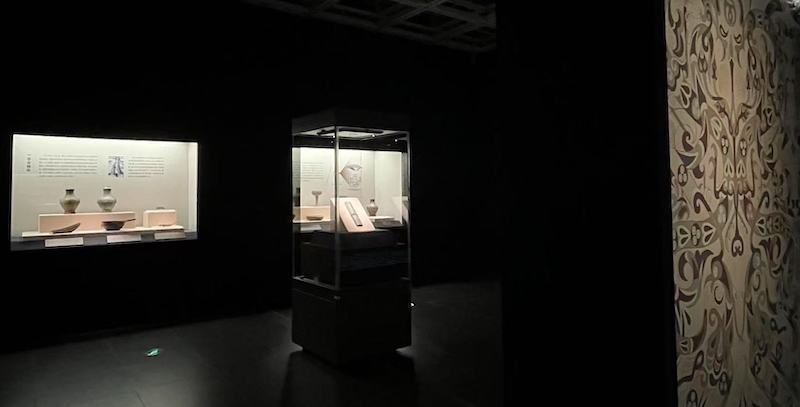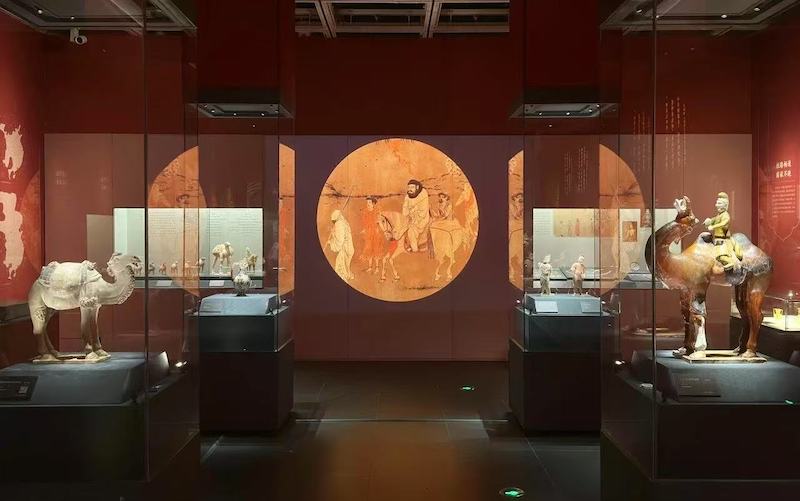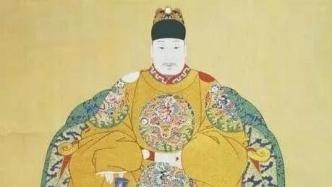
The State of Chu was first established during the reign of King Cheng of Zhou, rose during the Spring and Autumn Period and the Warring States Period, intimidated the Central Plains in the north and pacified the Baiyue in the south, and became a powerful nation.
"Chu Feng Lie - Anhui Chu Culture Cultural Relics Exhibition" will be on display at the Minhang District Museum in Shanghai on June 15. This is a special exhibition focusing on cultural relics from the late Chu State, presenting important cultural relics including the Qijin Festival (chariot festival) of the Ejun, the sword given by the King of Yue, and the bronze urn with a three-legged sheep head. This exhibition focuses more on the late Chu State, and tells the story of cultural relics such as the tiger-shaped bronze seat with the inscription "Fuping Jun" and the chime bells with coiled dragon patterns recovered from the Wuwang Dun Tomb. The Wuwang Dun Tomb is the largest, highest-level, and most complex Chu tomb scientifically excavated so far. On the occasion of Cultural and Natural Heritage Day, The Paper previewed it this morning.

Exhibition site
The reporter from The Paper learned that the exhibition is divided into three parts: "The Storm in Chu", "The Glory of Chu Objects" and "The Mysterious Palace of the King of Chu", presenting 129 pieces (sets) of cultural relics from the Anhui Museum, Huainan Museum and Anhui Chu Culture Museum.

Exhibition poster
Chu was a powerful state in the south that rose during the Spring and Autumn Period and the Warring States Period. It was also known as Jing, Jingchu, and Chuman. Its ancestors were granted land between the Yangtze River and the Han River during the reign of King Cheng of Zhou. After 800 years of governance, it had a large population, a strong military, and a vast territory, spanning parts of Hunan, Hubei, Henan, Anhui, Shanghai, Jiangsu, Zhejiang, Shandong, Jiangxi, Chongqing, and Sichuan. It was one of the famous "Five Hegemons of the Spring and Autumn Period" and "Seven Heroes of the Warring States Period" in history.

Exhibition site
Anhui is located in the hinterland of Jianghuai, with many states, and is an important area for the eastward spread of Chu culture. Since the middle of the Spring and Autumn Period, Chu and other states inside and outside the region launched a fierce struggle in the Jianghuai region, and finally unified Jianghuai in the early and middle Warring States period. In the first year of King Kaolie of Chu, Huang Xie, the Lord of Chunshen, was granted the title of Shouchun, and governed the "12 counties in Huaibei". In the "22nd year of King Kaolie (241 BC), he and other princes attacked Qin and left. Chu moved its capital to Shouchun in the east and named it 'Ying'". Shouchun became the political center of the late Chu State and served as the capital for 19 years. It served three kings, namely, King You of Chu Mi Han, King Ai of Chu Mi You, and King Fu Chu of Chu. In the fifth year of Fu Chu (223 BC), it was destroyed by Qin.

Wuwangdun Tomb Mound
The relevant person in charge of Minhang Museum told the reporter of The Paper that this exhibition focuses more on the late Chu State and tells the story of King Wu's Tomb. King Wu's Tomb is located in the north of Shungeng Mountain and in the south of open plains. It is more than ten kilometers away from Shouchun, the capital of Chu State. From 2015 to 2018, King Wu's Tomb was looted, and 77 pieces were recovered. Most of the cultural relics related to King Wu's Tomb in the exhibition also come from here. It is reported that King Wu's Tomb is the largest, highest-level and most complex Chu tomb scientifically excavated so far. It is also the first nine-chamber Chu tomb with a clear structure seen in China. It is the highest-level funeral ritual in Chu State.

Archaeological excavation data of Wuwangdun Tomb
Who is the owner of this Chu tomb? According to archaeological experts, the owner of Wuwangdun Tomb may be the Chu Kaolie King recorded in "Historical Records: Chu Family". He was Xiong Yuan (also known as "Wan"), the son of Chu Qingxiang King (reigned from 263 BC to 238 BC), who was once a "hostage" of Qin State. Later, with the help of Chunshen Jun Huang Xie, he escaped to Chu State and inherited the throne. It is understood that the well-known idioms such as "毛遂自荐", "歃血為盟" and "无王之劫" are all related to Chu Kaolie King: Mao Sui accompanied Zhao State Pingyuan Jun on a diplomatic mission to Chu State and met Chu Kaolie King; Mao Sui's trip was successful, and the two sides swore a blood oath to form an alliance; after the death of Chu Kaolie King, a dispute over the throne occurred, and Chunshen Jun did not listen to the warning of "无王之劫" and was killed.
Upon entering the exhibition hall, the first thing visitors see is a three-legged sheep-shaped bronze urn with a lid. The object is aluminum-black in color and consists of two parts: a lid and a body. It is 11 cm high, 14 cm long and 9.2 cm in diameter. It was unearthed in Xiaoyan Lake, Zhengyangguan Town, Shou County in 1977 and is one of the treasures of the Chu Culture Museum.

Exhibition site, three-legged sheep-shaped bronze urn with lid
The three-legged sheep-shaped bronze urn with a lid is shaped like a sheep, with a flat lid and a bridge-shaped semicircular button in the middle. One end is fan-shaped and tilted downward like a sheep's tail, and the tail is decorated with cloud and thunder patterns. It is a relic of Zhoulai State, which was active in Shou County and Fengtai during the Shang and Zhou Dynasties. Its unique shape and vivid form reflect the unique local style of Zhoulai State before it was influenced by the Chu culture.

The exhibition site, "The King of Yue's Will is Gifted" Sword

The exhibition site, "The King of Yue's Will is Gifted" Sword
In the area showing Chu weapons, the "Yue Wangzhe Zhiyu Ci" sword is located in the C position. This cultural relic was unearthed in January 1996 from the tomb of Cai nobles in the early Warring States Period in the Xiquan Cemetery in Shou County. It is composed of four parts: the sword body, the sword guard, the sword handle and the sword head. The sword head is trumpet-shaped, with two convex hoops on the handle, on which turquoise is inlaid with exquisite hook-and-loop cloud patterns. On both sides of the finely polished sword guard, turquoise is inlaid with a very beautiful white double-hooked hollow bird seal eight-character inscription: "King (Yue) King (Yue) Zhiyu Ci". This sword was cast by Yue Wang Goujian's son, Yu Yu, when he was in power. He gave this sword to Cai as a token of love, and later buried it in the tomb of Cai nobles. This sword reflects the friendly relations between Yue and Cai after Yue conquered Wu.

Exhibition site, Ejun Qijin Festival
The Golden Seal of E Jun Qi is a tax-free pass issued by the King of Chu to E Jun Qi in the middle of the Warring States Period for transporting goods. E is a place name, Qi is the name of E Jun, and the Golden Seal is his own name. There are inlaid gold inscriptions on the surface of the Golden Seal, with 148 characters on the car section and 164 characters on the boat section. From the historical facts recorded in the inscriptions on the Golden Seal, it can be known that this section was cast in the seventh year of King Huai of Chu, that is, 323 BC. The routes recorded on the Golden Seal are the water and land routes from E to Ying.
There are two types of golden festivals. The longer boat festival is a certificate for water transport, and the shorter car festival is used for land vehicle transportation. The two golden festivals record the amount of tax exemption, the scope of use, the duration of tax exemption, and prohibited materials when the caravan passes through the checkpoint. It is the earliest "tax-free pass" seen in my country. This cultural relic is also a precious historical material for studying the use of festivals, tariff system, water and land transportation, economic trade, historical geography, and the relationship between the King of Chu and the feudal lords. It is said that only five pieces of the Ejun Qi Golden Festival have been unearthed, which is very precious.

Exhibition site, bronze scale with Chinese characters from the Warring States Period
The Warring States copper measure with the Chinese character "王" has a square lip, a slightly narrowed straight mouth, a straight wall, a flat bottom, and a negative "王" character engraved on the upper left side, which looks like a mug today. It is reported that the body of the vessel is thick and regular, with green copper rust all over the inside and outside. This measure was an official measure of the Chu State in the Warring States Period. The inscribed "王" is rough and powerful, and was engraved under special circumstances after casting to demonstrate the authority of the user. As an official measure of the pre-Qin period, this measure has very important scientific research value.

Gold coins of the Chu State in the display cabinet at the exhibition site
During the Spring and Autumn Period and the Warring States Period, the economy of Chu State was long-term stable and prosperous, the domestic market was active, and the economic and trade exchanges with various countries were frequent. Therefore, the monetary system was developed, and the currency materials included gold, silver, bronze, shells, etc., and the currency types included ant nose coins, cloth coins, Yingyuan, etc. These gold coins were mainly used for transactions in bulk commercial activities. During the transaction process, people would use cutting tools and scales to cut, weigh and pay according to their needs. It is said that Chu State was the earliest and most widely used country in the pre-Qin period. In the exhibition, the organizer also specially set aside a group of display cabinets to present the gold coins of Chu State.

The exhibition site shows the tiger-shaped bronze base with the inscription "Fuping Jun"
At the end of the exhibition, the "Fuping Jun" inscribed tiger-shaped bronze base and the chime bells with coiled dragon patterns are musical instruments and cultural relics unearthed and recovered from the tomb of King Wu. They are important physical materials for studying the music culture, ritual system and bronze casting technology of the Chu State during the Warring States Period. They not only reflect the life style of the Chu royal family in the late Warring States Period, but also provide valuable clues for understanding the music history and ritual system of the Chu State. Among them, the Fuping Jun inscribed bronze tiger base is suspected to be the base of the chime bells. There are inscriptions on its back neck and tail, which are "Fuping Jun Wai Le Fu Xiang" and "Fifteenth Year March Cast Bai Yi". "Fuping" is a place name. Fuping County is now under the jurisdiction of Baoding, Hebei Province. It belonged to the State of Zhao during the Warring States Period; Wai music, relative to Nei music, refers to the musical instruments used in the outer court during banquets. "Fifteenth Year March Cast" records the time of casting.

Exhibition site, chimes
Behind the bronze tiger seat with the inscription of Fuping Jun are two groups of chime bells, one group with 9 pieces and the other with 14 pieces. Both are bronze button bells, decorated with coiled dragon patterns and basically well preserved. Button bells are the most common chime bells in the middle and late Warring States period. They belong to the category of gold percussion instruments and have a tile-shaped bell body. Both groups of chime bells have two tones, that is, striking the main drum and the side drum will produce two different scales. There are many tuning chisel marks on the inner cavity sound ridge, which are traces left by the ancient musicians who repeatedly tuned. After sound measurement, the scale of this group of chime bells is complete and the function of playing music is basically intact. Regarding Chu culture, the end of the exhibition reads: Even though Chu was destroyed by Qin, Chu's cultural genes still deeply influenced Qin. Since Qin was short-lived, the influence of Chu culture was able to continue to the Han Dynasty, deeply affecting the politics and culture of the Han Dynasty. To this day, we can still identify a large number of elements of Chu culture in many details of life in the former land of Chu. They have traveled through two thousand years of time and are still continuing their lives vividly and dynamically.
The exhibition will run until October 8th.


